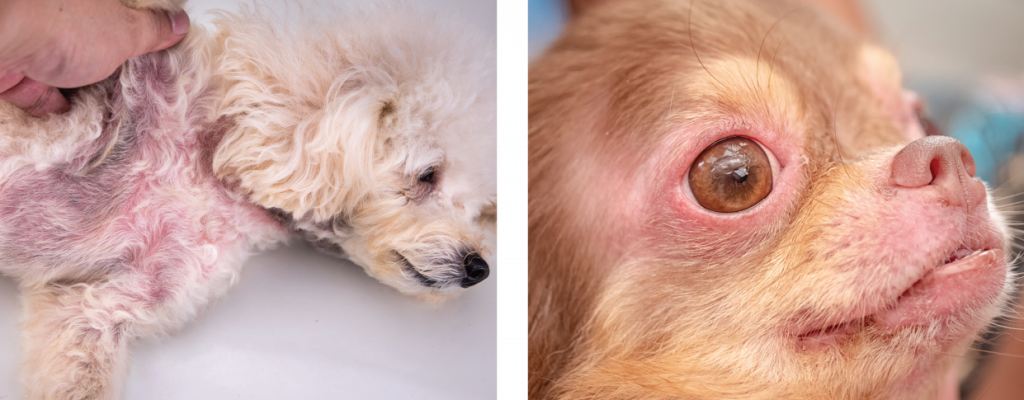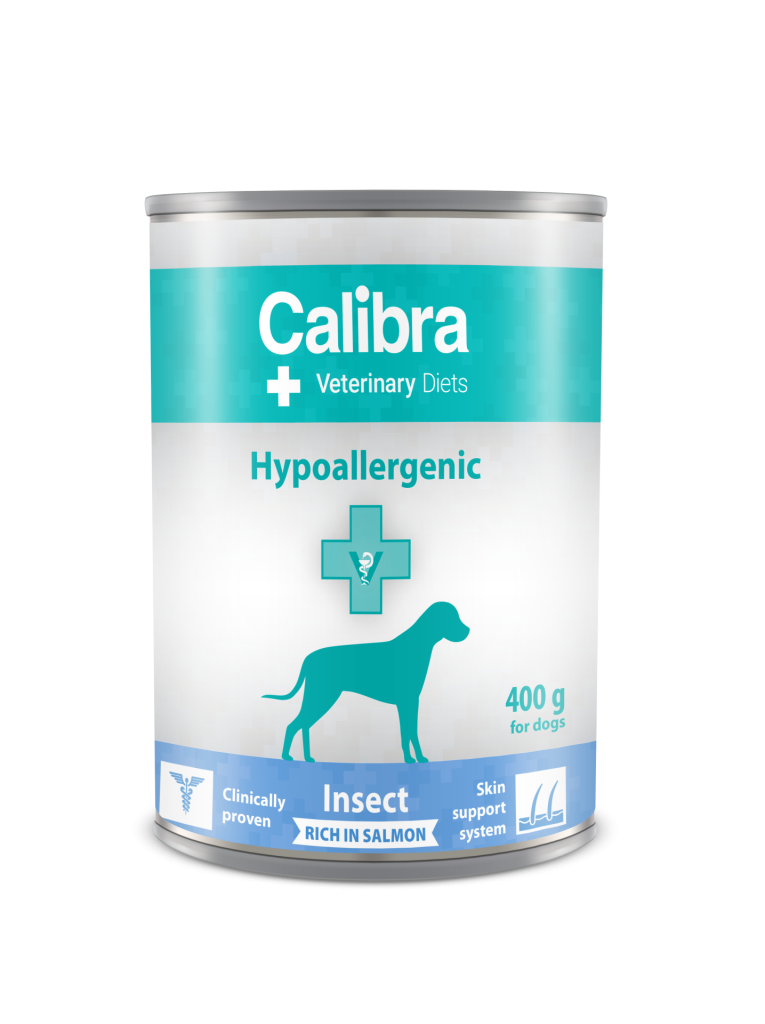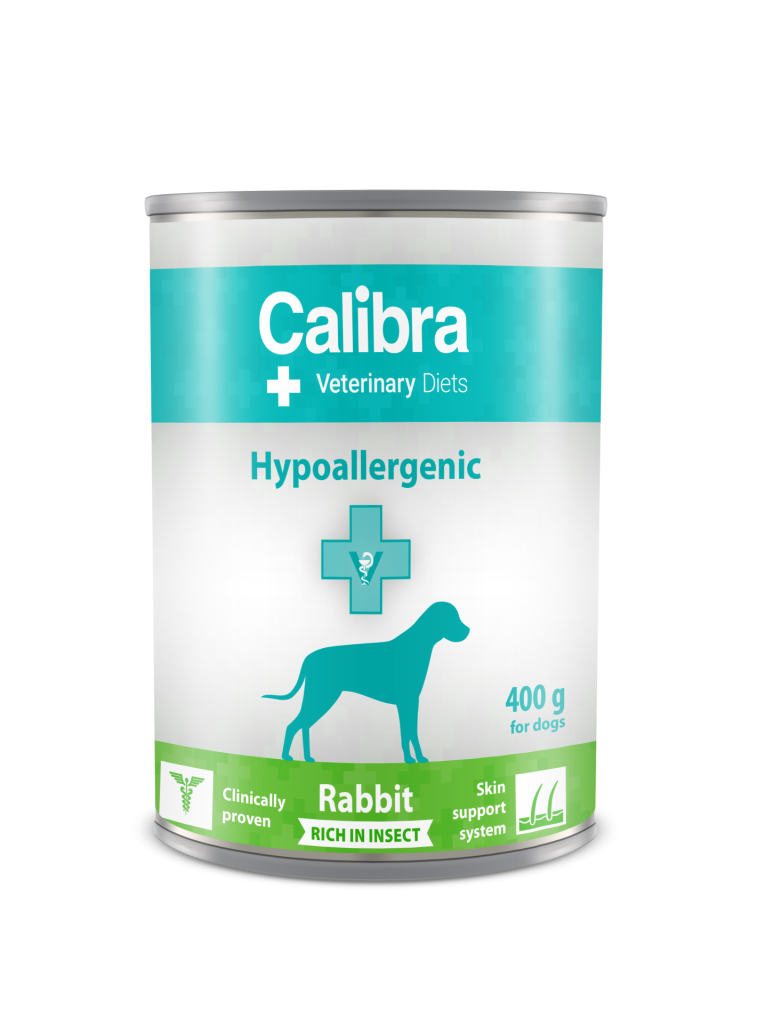VD Hypoallergenic Skin & Coat Support for dogs
18 August, 2021
Dog skin problems are one of the most common reasons for visiting a
veterinarian. Food allergies can also cause these problems. We will take a
closer look at the diet offered by the Calibra brand as part of its
veterinary diets.
In this article you will learn:
- What is an elimination diet and why is it used
- What options does Calibra Hypoallergenic Skin & Coat Support offer
- Why it is important to follow a diet and how long to feed this diet
My dog has been put on an elimination diet…
Just as in humans, animals can also suffer from AFR (adverse food reactions) or allergies to specific components of food. An allergy to certain components (antigens) of food can be a cause of non-seasonal pruritus (itching) – particularly around the eyes, ears, paws, and limbs. Secondary bacterial or yeast infections often lead to, for example, recurrent pyodermas (purulent skin inflammation) or other skin problems. In some patients, gastrointestinal symptomatology is also present.

Why to use an elimination diet?
An elimination diet is the gold standard for diagnosis of food sensitivities. Immunological tests (based on blood sample analysis) have a high rate of false positive results and very little connection with clinical symptoms.
False positive results mean that the test has identified a problematic allergen that the animal is not actually allergic to and that is not connected with any clinical signs.
What is an elimination diet?
The principle lies in the administration of a special diet under strictly defined patient management by the owner for a specified period.
Which diet is suitable?
 There are generally two options, each of which has its pros and cons.
There are generally two options, each of which has its pros and cons.
The first option is a home-cooked diet, in which the veterinarian explicitly defines the composition. Vets will generally select a single protein source (meat) and a single carbohydrate source (such as rice). The advantage is 100% control over the composition of the diet; while the disadvantages are potential nutritional imbalances as well as investment of time needed for regular preparation of fresh food. Only a small percentage of owners are capable of respecting the instructions of a nutritional expert and preparing a balanced diet containing
a special pre-mix.
An unbalanced diet is only suitable for adult animals and only for as long as necessary.
The second option is a complete commercial diet, of which there are two types.
- A fully hydrolysed diet – hydrolysis is a way of processing raw ingredients in which proteins are broken down into smaller chains with a lower molecular weight, which are not capable of activating an allergic reaction.
- A “NOVEL PROTEIN” diet – This diet is based on a special source of protein to which the animal has never been exposed and could therefore not have developed an allergy (for example fish meat for dogs, or exotic protein sources such as kangaroo and horse meat in Europe).
Both types are generally formulated based on the principle of reducing the number of inputs to one source of protein and one source of carbohydrates.
Which solutions does Calibra offer?
In the dry food category, Calibra offers the Dog Hypoallergenic Skin & Coat Support Veterinary Diet
This diet uses salmon, hydrolysed salmon, and potato starch. The diet is enriched with additives (salmon oil rich in omega-3, zinc, biotin, antioxidants) that support skin and coat. Based on expert studies, salmon meat has shown to be minimally allergenic (according to various sources, only 2% of dogs with AFR are allergic), and can therefore be used in an elimination diet.
Its strength lies in its ability to be used on a long-term basis for those animals who have shown allergic reactions to beef, chicken, lamb, corn, wheat, etc. For more complex cases and elimination diets, Calibra also offers two canned veterinary diets:


Calibra VD Dog Hypoallergenic Insect & Salmon 400 g
Calibra VD Dog Hypoallergenic Rabit & Insect 400 g
Is it essential to strictly adhere to the diet?
Generally, the most common cause of diet failure is “owner failure” – i.e. failure to comply with the strict procedures set by the veterinarian.
 The most critical point is the use of – and only the use of – the defined diet – this means absolutely no treats, supplements, or medications that have not been approved by the veterinarian. The cooperation of the entire family is essential (including children and other family members), who, in unguarded moments, give in to the dog‘s “sad eyes” and offer “better” treats, biscuits, or bones. Unfortunately, this completely disrupts the entire lengthy and expensive therapeutic and diagnostic process.
The most critical point is the use of – and only the use of – the defined diet – this means absolutely no treats, supplements, or medications that have not been approved by the veterinarian. The cooperation of the entire family is essential (including children and other family members), who, in unguarded moments, give in to the dog‘s “sad eyes” and offer “better” treats, biscuits, or bones. Unfortunately, this completely disrupts the entire lengthy and expensive therapeutic and diagnostic process.
The dog must be under constant supervision (even in the yard or on walks) to ensure that they do not consume anything (potential allergen) outside the home. A muzzle is a good idea for those dogs who are chronic “grazers”.
Usage period and further steps
Your veterinarian will decide on the period of use based on a full patient examination. In general, we recommend that the dog remain on the elimination diet for 8 weeks.
 If the symptoms disappear, the veterinarian will usually prescribe a challenge, meaning they will take the animal off the elimination diet and return it to its previous diet. If the symptoms return (within around ten days), the patient is considered to have a food allergy and must be put back on the elimination diet or search for other long-term alternatives.
If the symptoms disappear, the veterinarian will usually prescribe a challenge, meaning they will take the animal off the elimination diet and return it to its previous diet. If the symptoms return (within around ten days), the patient is considered to have a food allergy and must be put back on the elimination diet or search for other long-term alternatives.
Will the elimination diet need to be used long-term, or even permanently?
Fortunately, in most cases, an alternative diet can be found. Your veterinarian will analyze the diet that caused the clinical symptoms and suggest the use of a different, better-defined diet to avoid the likely allergen(s). The determination of the specific allergen(s) is possible through repeated challenge tests, which are time-consuming and difficult to organize.
Examples of alternative acceptable foods can be the use of a diet based on salmon-potato, or lamb and rice.
